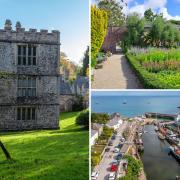St Austell has flourished with great restaurants, beaches and a new shopping centre

In the past few years St Austell has flourished and, with a strong community spirit and a new shopping centre, it's a great place to live, writes IAN WILKINSON...
John Wesley's description of St Austell as a neat little town on the side of a fruitful hill holds good to this day, although with the passage of time the town can hardly be described as little. It will come as a surprise to many to learn that it is in fact the largest single town in the county in terms of population!
St Austell is mentioned in the Domesday Book and takes its name from a rather obscure Celtic saint who, in the 6th century, tarried awhile in the area while journeying from Wales to Brittany. For centuries the town itself remained obscure until deposits of tin and copper were discovered, followed by china clay in the late 18th century. Mining transformed the town's fortunes and is still an important factor in the economy of the area to this day.
In the last few years St Austell has flourished and there are at least seven reasons why it is well worth considering as a place to call home.
1 Good housing and community spirit
Houses in St Austell and the surrounding area range from detached mansions with sea views to tiny two-up and two-downs near the town centre. In between these extremes you will find a real mixture of modern and Victorian housing, purpose-built apartments, new estate housing and converted barns and farmhouses.
2 Heritage
In the town centre is the magnificent 15th-century church with its carved figures representing the Apostles, the Trinity and the Annunciation. Opposite is the 19th-century granite Market House with its fine timbered roof and quaint noticeboards listing the fees and charges payable by traders in bygone days. Fore Street is a mixture of new and old but at its western end, counter-balancing the historic central area, is the brand new shopping centre.
3 Shopping
For many years the town offered a reasonable range of shops. A mix of well-known multiples and local outlets provided the townsfolk and those from the surrounding area with most of life's essentials and a few luxuries as well. However, in October 2009 the opening of the 75m White River Place development greatly enhanced the towns overall shopping experience. There's a new multi-screen cinema, shops, bars, cafes and restaurants as well as a much needed car park and 69 residential apartments. The historic Market House has a number of small specialist shops and a local produce market is held outside on Saturdays. Market shopping on quite a different scale can be had just out of town.
Cornish Market World is the largest indoor market in the region, with nearly 100 individual stallholders selling everything from local Cornish food to antiques and from household goods to fashion. It is open every weekend throughout the year and on Wednesdays during the summer.
4 A central location
St Austell is on the south coast about halfway between the Tamar and Lands End, with road links to Truro in the west, Lostwithiel and Liskeard in the east and Bodmin and the main A30 and A38 to the north. Truro is about 20 minutes drive away and Plymouth, with its international airport and ferry port, is just under an hour away. Crucially, it is also on the main railway line linking Truro and Falmouth to Plymouth and London. There is also an excellent local bus network and there are few places in the county that you cant reach if you are dependent on public transport.
5 A good night out
The town is home to the St Austell Brewery, a family business that has been brewing fine Cornish ales since 1863, and the company owns a number of hostelries in the town. My favourites are the venerable White Hart, a solid granite-built epitome of the English hotel, the rather more exuberant Seven Stars (which was the first pub ever owned by Walter Hicks, the founder of the brewery) and the Hop and Vine on Market Street. All of the pubs serve good food, but for that special evening out two restaurants spring to mind. The first is the Boscundle Manor restaurant in Tregrehan where you can enjoy fine dining in the elegant surroundings of this 18th-century manor house. The second is Austells, which is situated on the road to Carlyon Bay and offers modern British cuisine, exquisitely cooked.
6 Charlestown
The ancient port of St Austell is something of a gem. Used in countless film sets in recent years, Charlestown has seen no major change since the days of the square riggers some of which can be seen in the dock basin. The waterfront is always teeming with life and activity and its a real pleasure to watch the craftsmen at work on the historic ships, using skills that you may have thought had been lost forever. A walk around the harbour wall is a delight.
7 Surrounding attractions
There are many attractions within half an hours drive of St Austell but two of the closest are outstanding and both have their roots in the china clay industry. The first, the Eden Project, requires little introduction. Its huge biomes, set in a disused quarry, are world famous and its message concerning the relationship between plants, humans and a sustainable environment is more relevant today than it has ever been. The second attraction is the China Clay Country Park at Wheal Martyn, which combines a fascinating museum with a trail and a viewing platform overlooking a china clay pit where white gold was mined.
DID YOU KNOW?
Chemist William Cookworthy discovered large amounts of china clay in St Austell in the 18th century, putting the town on the map?
St Austell Brewery has been brewing beer and real ale in Cornwall since 1851 and runs 174 pubs in the South West?
St Austell is part of the Cornish Riviera, so-called because of its gorgeous beaches?



























